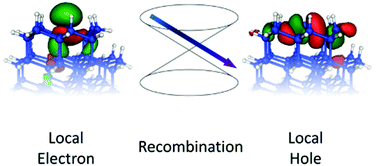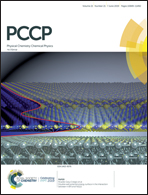Locality of conical intersections in semiconductor nanomaterials†
Abstract
A predictive theory connecting atomic structure to the rate of recombination would enable the rational design of semiconductor nanomaterials for optoelectronic applications. Recently our group has demonstrated that the theoretical study of conical intersections can serve this purpose. Here we review recent work in this area, focusing on the thesis that low-energy conical intersections in nanomaterials share a common feature: locality. We define a conical intersection as local if (a) the intersecting states differ by the excitation of an electron between spatially local orbitals, and (b) the intersection is accessed when the energies of these orbitals are tuned by local distortions of the geometry. After illustrating the locality of the conical intersection responsible for recombination at dangling bond defects in silicon, we demonstrate the locality of low-energy conical intersections in cases where locality may be a surprise. First, we demonstrate the locality of low-energy self-trapped conical intersections in a pristine silicon nanocrystal, which has no defects that one would expect to serve as the center of a local intersection. Second, we demonstrate that the lowest energy intersection in a silicon system with two neighboring dangling bond defects localizes to a single defect site. We discuss the profound implications of locality for predicting the rate of recombination and suggest that the locality of intersections could be exploited in the experimental study of recombination, where spectroscopic studies of molecular models of defects could provide new insights.

- This article is part of the themed collection: 2019 PCCP HOT Articles


 Please wait while we load your content...
Please wait while we load your content...
